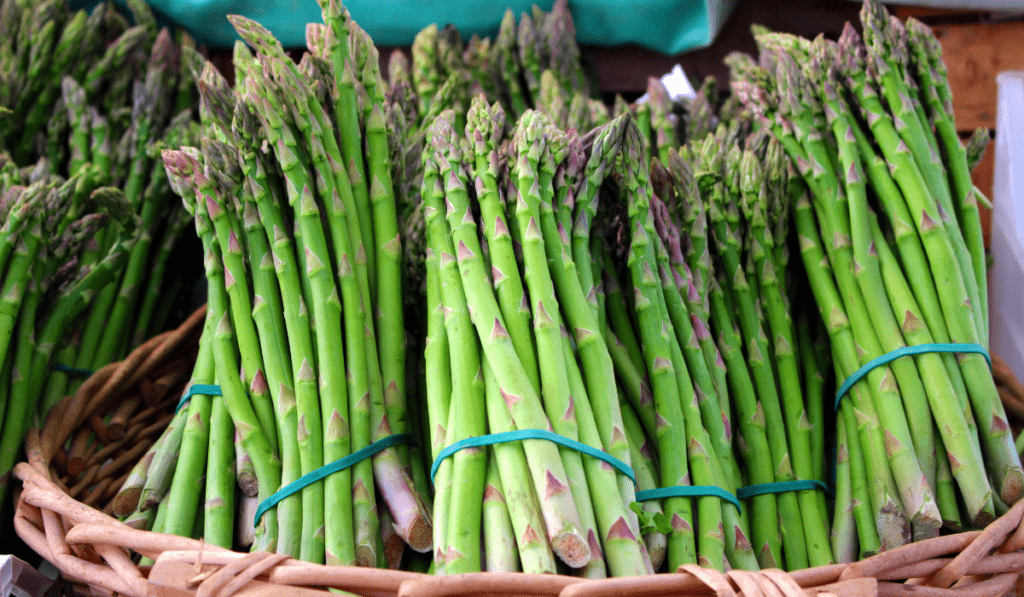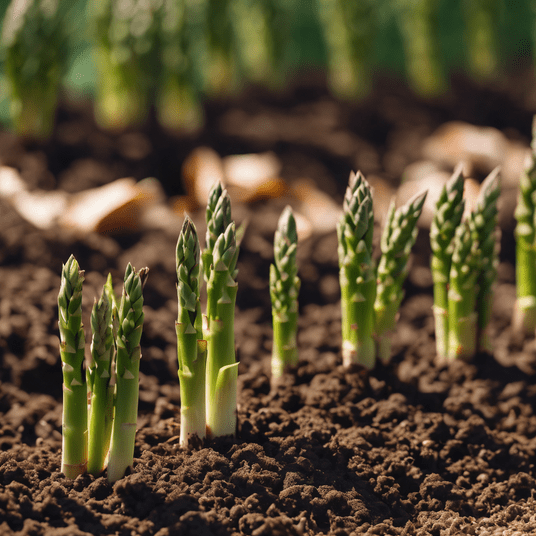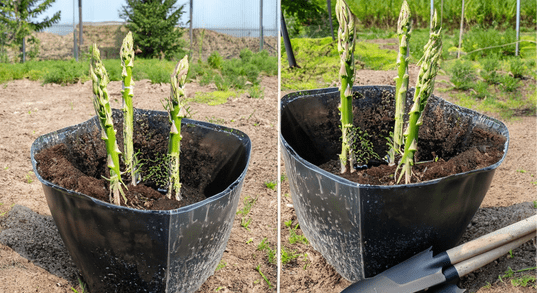Asparagus, hailed as the “king of vegetables,” is not only a delectable addition to your plate but also a rewarding crop to cultivate in your own backyard. Its succulent spears, packed with nutrients, make it a favorite among gardeners and health enthusiasts alike. However, to truly enjoy a bountiful harvest, understanding the intricacies of caring for asparagus is paramount.
In this comprehensive guide, we’ll walk you through every stage of the asparagus growing journey, from selecting the right variety to savoring the fruits of your labor. Whether you’re a seasoned gardener or a novice with a green thumb, this guide will equip you with the knowledge and skills needed to cultivate thriving asparagus beds.
Why Grow Asparagus?
Nutritional Value and Health Benefits
Asparagus isn’t just a tasty addition to your meals; it’s a nutritional powerhouse. Packed with vitamins, minerals, and antioxidants, asparagus offers a range of health benefits. Rich in folate, fiber, and vitamins A, C, and K, it supports overall well-being and contributes to a healthy diet.
Economic and Environmental Reasons
Growing your own asparagus can also be economically savvy. Once established, an asparagus bed can produce abundant spears for up to 20 years, saving you money on grocery bills. Furthermore, cultivating perennial crops like asparagus promotes sustainability, reducing the need for frequent replanting and minimizing environmental impact.
The Joy of Growing Your Own Food
There’s a unique satisfaction in sowing seeds, nurturing plants, and reaping the rewards of your efforts. Asparagus, with its gradual growth and seasonal harvest, allows you to connect with the rhythm of nature. The joy of walking into your garden and harvesting fresh asparagus for dinner is an experience that goes beyond the culinary delight it brings.
Getting Started: Choosing the Right Variety
Selecting the right asparagus variety is a crucial first step in ensuring a successful harvest. Varieties differ in terms of climate suitability, taste, and spear color. Consider the following factors when making your choice:
Climate Suitability
Asparagus varieties are categorized into three main types based on their suitability to different climates:
- Northern Varieties:
- Characteristics: Northern varieties are well-suited for cooler climates with cold winters.
- Recommended Regions: Ideal for northern regions with colder temperatures during the winter months.
- Examples: ‘Jersey Knight’ and ‘Mary Washington’ are popular northern varieties known for their cold tolerance and resilience.
- Southern Varieties:
- Characteristics: Southern varieties are adapted to warmer climates with milder winters.
- Recommended Regions: Well-suited for regions with mild winters and hot summers, such as the southern United States.
- Examples: ‘UC 157’ and ‘Purple Passion’ thrive in southern climates and offer excellent heat tolerance.
- Midseason Varieties:
- Characteristics: Midseason varieties strike a balance, offering adaptability to a wide range of climates.
- Recommended Regions: Suitable for areas with moderate temperatures, making them versatile for both northern and southern regions.
- Examples: ‘Guelph Millennium’ and ‘Apollo’ are midseason varieties that perform well in various climates.
When selecting an asparagus variety, consider your specific climate and local weather conditions. Consult with local agricultural extension services or nurseries to identify varieties that have proven success in your region. Additionally, take note of the average temperatures and frost dates in your area to align your choice with the natural conditions of your location.
In the next sections, we’ll delve into the process of preparing the soil and planting asparagus, ensuring that you create an optimal environment for your chosen variety to flourish.
Planning and Preparing the Asparagus Bed
Before delving into the planting process, it’s essential to set the stage for your asparagus bed. Follow these steps for optimal results:
Selecting an Appropriate Site
Asparagus thrives in well-drained soil with a slightly acidic to neutral pH. Choose a location with full sunlight exposure, as asparagus plants require at least 8 hours of sunlight daily. Avoid areas prone to waterlogging, as excess moisture can lead to root rot.
Preparing the Soil
- Soil Testing: Conduct a soil test to determine nutrient levels and pH. Asparagus prefers a pH range between 6.5 and 7.5. Amend the soil based on the test results, adding organic matter if necessary.
- Creating Raised Beds: Asparagus benefits from well-drained soil, making raised beds an excellent choice. Build raised beds to improve drainage and provide a loose, friable planting environment.
Tips for Spacing and Planting Depth
- Crowns vs. Seeds: Asparagus is typically grown from crowns or seeds. Crowns are recommended for beginners as they establish more quickly. Plant crowns in trenches, while seeds can be sown directly in the soil.
- Spacing: Plant crowns or sow seeds at least 18 inches apart within rows. Allow 4 to 5 feet between rows to facilitate air circulation.
- Planting Depth: Place crowns or seeds in the soil at a depth of 6 to 8 inches. Cover them with a layer of soil and gradually fill the trench as the plants grow.
Planting Asparagus: Step-by-Step Guide
Now that your asparagus bed is prepared, it’s time to initiate the planting process. Follow these steps for a successful start:
- Timing: Plant asparagus in early spring, as soon as the soil is workable. In warmer climates, fall planting is also an option.
- Soaking Crowns: If you’re planting crowns, soak them in water for a few hours before planting to rehydrate the roots.
- Trenching: Dig trenches for crowns or furrows for seeds, following the spacing guidelines mentioned earlier.
- Placing Crowns or Seeds: Set crowns in the trench with roots spread out, or sow seeds at the recommended spacing.
- Covering and Watering: Cover the crowns or seeds with soil and water thoroughly. Maintain consistent moisture during the initial growth period.
Early Care: Watering, Fertilizing, and Mulching
Importance of Consistent Watering
Establishing a consistent watering routine is crucial for the early development of asparagus plants. Water deeply, ensuring the soil remains consistently moist but not waterlogged.
Choosing the Right Fertilizer
Asparagus is a heavy feeder, requiring regular doses of nutrients for optimal growth. Apply a balanced fertilizer or a specialized asparagus fertilizer according to the recommended rates. Begin fertilizing in the second year after planting.
Mulching Guidelines for Newly Planted Asparagus
Mulching helps retain soil moisture, suppress weeds, and regulate soil temperature. Apply a layer of organic mulch, such as straw or compost, around asparagus plants. Leave a gap around the crown to prevent rot.
Asparagus Ferns: Understanding Growth and Maintenance
Allowing Ferns to Grow and Develop
After the initial planting and establishment phase, asparagus plants will send up fern-like foliage. These ferns play a crucial role in replenishing the plant’s energy reserves for the next growing season. Allow the ferns to grow without disturbance, as they contribute to a healthier and more robust asparagus bed.
Trimming and Maintaining Ferns for a Healthy Harvest
- Selective Trimming: While allowing ferns to grow, you may selectively trim back some of the taller or bushier fronds. This helps improve air circulation and prevents diseases.
- End-of-Season Cleanup: In late fall, after the ferns have turned yellow, cut them down to ground level. Remove and compost the foliage to reduce the risk of overwintering pests and diseases.
Addressing Common Concerns about Fern Growth
- Yellowing Ferns: Yellowing ferns could indicate nutrient deficiencies or pest issues. Conduct a soil test to identify any deficiencies and address them with appropriate fertilization.
- Thin or Sparse Ferns: Ensure proper spacing during planting, and provide adequate nutrients. Thinning crowded areas can encourage healthier fern growth.
Weed and Pest Management
Identifying Common Weeds and Strategies for Control
- Common Weeds: Asparagus beds are susceptible to weeds that can compete for nutrients and water. Identify common weeds such as crabgrass and dandelions.
- Weed Control Methods: Use a combination of mulching, hand weeding, and, if necessary, pre-emergent herbicides to control weeds. Avoid using herbicides close to asparagus plants to prevent damage.
Natural and Chemical Methods for Pest Control
- Common Pests: Asparagus beetles and aphids are common pests that can affect asparagus. Regularly inspect plants for signs of infestation.
- Natural Control: Encourage natural predators like ladybugs and lacewings. Neem oil and insecticidal soap are effective organic options.
- Chemical Control: If pest populations become problematic, consider targeted chemical insecticides. Follow product instructions and apply judiciously.
Disease Prevention and Management
Common Diseases Affecting Asparagus
- Fusarium and Verticillium Wilt: These fungal diseases can affect asparagus. Ensure proper soil drainage and avoid planting in areas with a history of these diseases.
- Rust: Identify rust-like spots on ferns. Improve air circulation and consider fungicidal treatments if necessary.
Tips for Preventing Diseases
- Rotate Crops: Avoid planting asparagus in the same location year after year to reduce the risk of soil-borne diseases.
- Proper Watering: Water at the base of the plants to keep foliage dry, minimizing the risk of fungal diseases.
- Prompt Removal: Remove and destroy any infected plant material promptly to prevent the spread of diseases.
- Resistant Varieties: Choose asparagus varieties with resistance to common diseases prevalent in your region.
Conclusion:
Growing asparagus is an enriching journey from selecting the right variety to overcoming growth challenges, pests, and diseases. It’s not just a delicious addition to meals but a rewarding crop offering health benefits and the joy of homegrown food.
Understanding climate-appropriate varieties is vital for success, catering to various climates from frosty regions to warmer areas. Careful planning, like choosing a sunny, well-drained site and deciding between crowns and seeds, ensures robust asparagus plants.
Respecting the growth of fern-like foliage is crucial; it sustains future harvests. Learning to trim and care for these fronds significantly impacts the bed’s health.
Managing weeds, pests, and diseases is essential. Balancing natural and chemical methods fosters harmony in your garden, protecting your crop.
Preventing diseases through techniques like crop rotation and proper watering fortifies your plants against common threats.
This guide equips both seasoned and novice gardeners with the skills for thriving asparagus beds. Embrace the journey, relish the harvests, and enjoy the freshness of homegrown asparagus at your table. Happy growing!



